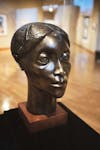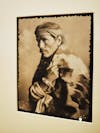6 items found for your search. If no results were found please broaden your search.
(04/20/22 10:47pm)

Elizabeth Catlett was a sculptor and artist who explored the black experience through her works. This piece, “Glory,” depicts Glory Van Scott, a famed dancer and cousin to Emmett Till. Abigail Solon, student curator, describes the meaning behind Catlett’s art choices: “Taking advantage of the bronze sheen, Catlett depicts Glory as noble and heroic."
(04/20/22 10:46pm)

“Half-Breed Navajo Chief,” by William Pennington, is a portrait photograph from around 1900. Isobella Dale, student curator, writes of the image: “These stereotypical images of Native Americans as stoic and sad reflect the popular belief in a ‘disappearing’ nation that was unable to respond and engage with the societies built by Western settlers.”
(04/20/22 10:45pm)

“Reflections: Visual Constructions of Race” includes sculptures, cultural artifacts and abstract works. Curated by students in the Fall 2021 Art and Architecture History Senior Capstone, Pepper Stelter, professor of art history and advisor of the project, and Jason Shaiman, exhibitions curator, the project focuses on the connection between art and race.
(04/20/22 10:44pm)

These three pieces are all from artist Harvey Breverman. The pieces are titled “Susan Howe” (left), “Carl Dennis” (top right) and “Robert Duncan” (bottom right). Each depicts an influential American poet.
(04/20/22 10:43pm)

The foreground pot, titled “Olla,” also sits in the “From the Ground Up” gallery. “Olla” is a type of cooking pot and is an example of coil-building, which creates strong, thick pieces of pottery.
(04/20/22 10:42pm)

Based on “Monkey Effigy Mold” and contributed by Richard James, assistant professor of ceramics at Miami, these two pieces are on display in the “From the Ground Up” gallery that explores different methods of making pottery. Patrons are encouraged to pick up this mold and effigy set to examine how mold-formed pottery is made.






